| Badung
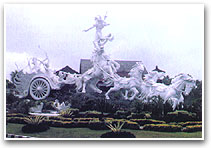 The
district of Badung covers less than one tenth of the island,
but it is the most highly populated region and plays an
important role in modern in Bali, as the seat of provincial
Government is in Denpasar, Bali’s capital city. The major
tourist resort of Sanur, Kuta and Nusa Dua form the southern
constituents of the regency, and to the north it stretches as
far as Mengwi and Sangeh, a mosaic of highly productive rice
fields interspersed with meandering rivers that have carved
many deep valleys through the landscape on their journey from
the mountains to the sea. The
district of Badung covers less than one tenth of the island,
but it is the most highly populated region and plays an
important role in modern in Bali, as the seat of provincial
Government is in Denpasar, Bali’s capital city. The major
tourist resort of Sanur, Kuta and Nusa Dua form the southern
constituents of the regency, and to the north it stretches as
far as Mengwi and Sangeh, a mosaic of highly productive rice
fields interspersed with meandering rivers that have carved
many deep valleys through the landscape on their journey from
the mountains to the sea.
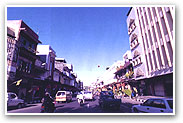 The capital of the Badung district, Denpasar is the
largest city on the island, a bustling, noisy city that has
recently been extended to the southeast in a large
administrative district known as the Niti Mandala, where the
major offices of government are situated. Here, fronted by a
fine stretch of rice fields, can be found the major offices of
the Governor, the Department of Tourism, the Department of Law
and Immigration, Finance, Education and Agriculture, along
with the central Post Office and Television Station. In other
words, this is the heart of administration for modern Bali,
the intermediary link between National Government in Jakarta
and the local Balinese Government. In the centre of town there
is large open Puputan square, named after the suicidal
confrontation in 1906 between the Rajas of Badung and the
Dutch army. On the eastern side of this is the Museum Bali and
the relatively new state temple, Pura Jagatnatha. On the
opposite side is the National Military Headquarters for Bali,
and on the northern side the Governor’s residence. At the
northwest corner of this square is the main intersection that
leads to the major streets of Gajah Mada and Veteran street.
Here a great four-faced statue stands in the midst of a
roundabout, an image of the god Guru in his traditional Hindu
manifestation as the lord of the four dimensions. In front of
the Governor’s residence, dominating the large grassy square,
is a statue commemorating the puputan massacre in dramatic
contemporary Indonesian style. The capital of the Badung district, Denpasar is the
largest city on the island, a bustling, noisy city that has
recently been extended to the southeast in a large
administrative district known as the Niti Mandala, where the
major offices of government are situated. Here, fronted by a
fine stretch of rice fields, can be found the major offices of
the Governor, the Department of Tourism, the Department of Law
and Immigration, Finance, Education and Agriculture, along
with the central Post Office and Television Station. In other
words, this is the heart of administration for modern Bali,
the intermediary link between National Government in Jakarta
and the local Balinese Government. In the centre of town there
is large open Puputan square, named after the suicidal
confrontation in 1906 between the Rajas of Badung and the
Dutch army. On the eastern side of this is the Museum Bali and
the relatively new state temple, Pura Jagatnatha. On the
opposite side is the National Military Headquarters for Bali,
and on the northern side the Governor’s residence. At the
northwest corner of this square is the main intersection that
leads to the major streets of Gajah Mada and Veteran street.
Here a great four-faced statue stands in the midst of a
roundabout, an image of the god Guru in his traditional Hindu
manifestation as the lord of the four dimensions. In front of
the Governor’s residence, dominating the large grassy square,
is a statue commemorating the puputan massacre in dramatic
contemporary Indonesian style.
Denpasar
Municipality
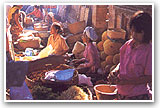 Denpasar actually means "north of the market" and
the city has always been the bustling hub of commerce for
South Bali. Just off the main street, beside the river, are
the markets of pasar Badung and Kumbasari shopping centre.
Every night by about 11.00 pm women arrive from near and far
with truckloads of produce and a bustling night market begins
along the river embankment, lasting until dawn. The market
proper, in its spacious new three-story building on the east
banks of the river, begins in stages as the other is being
cleared away. The large parking area starts to fill up before
dawn, and the first sticks of incense are placed at the Pura
Melanting for the Goddess of prosperity as the market slowly
stirs itself and increases tempo to the peak hustle and bustle
of the day. Denpasar actually means "north of the market" and
the city has always been the bustling hub of commerce for
South Bali. Just off the main street, beside the river, are
the markets of pasar Badung and Kumbasari shopping centre.
Every night by about 11.00 pm women arrive from near and far
with truckloads of produce and a bustling night market begins
along the river embankment, lasting until dawn. The market
proper, in its spacious new three-story building on the east
banks of the river, begins in stages as the other is being
cleared away. The large parking area starts to fill up before
dawn, and the first sticks of incense are placed at the Pura
Melanting for the Goddess of prosperity as the market slowly
stirs itself and increases tempo to the peak hustle and bustle
of the day.
Here one finds everything from fish
and meat, fruit, vegetables, spices, dried goods, hardware and
commodities, to clothing, weavings and basketry.
Kumbasari, on the opposite side of
the river, is more of an art market. It has an extension of
the daily market at ground level and then tier upon tier of
art shops that display a full range of crafts from antique
woodcarvings to woven materials and paintings. This huge
shopping complex is open till 8.00 pm each night.
Just to the south of this complex,
further down the river bank, is an area which comes alive in
the evening with brightly-lit food stalls, and kiosks selling
a variety of clothes, batiks, shoes, and other bargain-priced
items. This is the night market, or Pasar Malam, a popular
place amongst the locals and visitors alike to eat and shop at
night.
Only two streets north of Gajah
Mada, on the corner of Nakula street and Veteran street, is
the dealer’s art market, Pasar Satria, a sort of half-way
house between artist and art-shop for woodcarvings, paintings
and other craft items. Here you are bound to get a good
bargain, as prices start at wholesale level, but it is
necessary to have a good eye for quality, as sometimes rejects
are sold alongside superior pieces, with flaws that only an
experienced eye can detect. The art-market section is on the
two spacious upper floors, and there is a daily produce and
commodity market at ground level.
 The bird market, Pasar Burung, is just a little
further up veteran street at the entrance to the Puri Satria.
Parakeets and cockatoos, songbirds and pigeons sometimes-even
peacocks, are sol here along with a variety of animals,
puppies, rabbits, and monkeys. The bird market, Pasar Burung, is just a little
further up veteran street at the entrance to the Puri Satria.
Parakeets and cockatoos, songbirds and pigeons sometimes-even
peacocks, are sol here along with a variety of animals,
puppies, rabbits, and monkeys.
East Denpasar’s majored market
Pasar Kreneng is also a major bus terminal for public
transportation to east and central Bali. The large open
produce market and shopping centre closes down in the
afternoon just as stalls are being set up outside for the
brightly lit night market. Browsing here in the evening can be
great fun, and you can watch food being freshly prepared at
the many food stalls and sample local delicacies.
Another popular night market is the
Pasar Malam Pekambingan, just of Diponegoro street, in front
of the new Kerthawijaya shopping centre. Strictly for food,
and incredibly reasonably priced, it is very popular amongst
the local townspeople. Eating out at these tiny "restaurants
on wheels", seated under canvas awnings, provides a vignette
of local life few people experience.
A recent addition to Denpasar’s
market collection is the modern supermarket at the northern
and of Jalan Sudirman known as Pasar Swalayan. Previously a
youth centre, the huge hall has been converted to a modern
shopping centre with amusement facilities for children’s
playground and bird park.
South Denpasar has its Pasar
Sanglah, a bustling morning market which starts early, reaches
its peak at about 6.00 a.m., and is quiet again by
mid-morning, with the odd late shopping wandering through.
There’s also a Pasar malam just around the corner, much
frequented by the university students from the nearby
campus.
The Ubung bus station in northwest
Denpasar, terminal for public transport to west Bali and Java,
is also a bustling market, an ideal place to stop and pick up
fresh fruit on any westward journey.
Scattered throughout the city is
many other early morning markets that materialize in public
areas, at the side of the road and under banyan trees in the
wee small hours of the morning. These markets are short-lived
affairs, serving the daily requirements of the local populace
with fresh fish, meat, vegetables, fruit and the all-important
offerings of delicately woven palm leaf and flowers. One has
to be early, as they begin at daybreak and by eight or nine
o’clock all that remains is a solitary sweeper cleaning up the
remains.
Sanur main market is the pasar
Sindhu, which also has a little art market associated with it.
Kuta also has a bustling market just off the main road to the
airport, and in behind this is a popular night market where
one can find excellent seafood and satays. Right down at the
beach, at the and of jalan Bakungsari is a large art market,
full to the brim with attractive souvenirs, colorful T-shirts
and a range of local handicrafts.
A Wealth of
Handicrafts
If you are interested in Bali’s
handicrafts, a visit to the permanent trade display exhibited
at the Regional Trade Office of Bali at Kamboja Street No. 8
Denpasar, is a must. This centre offers information on all
Balinese handicrafts, and has a representative display well
worth seeing.
The Department of Industry also has
a special project for the Guidance and Development of Small
Industries (BIPIK), with a display room in Tohpati, east
Denpasar. Here one can obtain information on all the small
home industries, including textiles, woodcarving,
metalworking, bamboo and ceramics, scattered over the entire
island of Bali.
There is also an Art Cooperative,
the Sanggraha Kriya Asta, in Tohpati. Supervised by the
Department of Industry, this attractive centre has five
buildings, each displaying a major craft. Prices are fixed,
and very reasonable. There are weavings, garments, batik,
carvings, silver, and some paintings can be purchased
here-between 8.00 am and 16.13 every day except
Monday.
Gold
Jewellery
 Denpasar is the place to buy gold. Many of the shops
specializing in gold jewellery can be found near the central
mosque at the intersection of Hasanudin street and Sulawesi
street. Balinese traditionally keep much of their wealth in
gold jewellery, which is sold by weight, and these shops do
bustling trade with the local populace. Denpasar is the place to buy gold. Many of the shops
specializing in gold jewellery can be found near the central
mosque at the intersection of Hasanudin street and Sulawesi
street. Balinese traditionally keep much of their wealth in
gold jewellery, which is sold by weight, and these shops do
bustling trade with the local populace.
Antiques
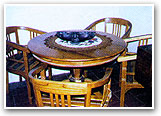 Antiques shops are also common in the inner city.
The Arts of Asia Gallery, hidden at the rear of a shopping
complex just off Jalan Thamrin has perhaps the widest
collection of items from all over Asia. There are old
Gringsing weavings from Tenganan, ceramic, wayang kulit
puppets, and some priceless krisses with jewel studded golden
handles. A number of excellent collections of local antique
statues, wooden carved doors and beds, and pieces of old
furniture can be seen in the antique shops scattered along
Jalan Arjuna and Jalan Gatot Kaca, just of the main street of
Denpasar. Antiques shops are also common in the inner city.
The Arts of Asia Gallery, hidden at the rear of a shopping
complex just off Jalan Thamrin has perhaps the widest
collection of items from all over Asia. There are old
Gringsing weavings from Tenganan, ceramic, wayang kulit
puppets, and some priceless krisses with jewel studded golden
handles. A number of excellent collections of local antique
statues, wooden carved doors and beds, and pieces of old
furniture can be seen in the antique shops scattered along
Jalan Arjuna and Jalan Gatot Kaca, just of the main street of
Denpasar.
Gamelan
Instruments
For those who are interested in
Balinese musical instruments, but don’t have time to visit the
village foundrys, pay a visit to the showroom of UD. Gema
Kencana in Tohpati, which belongs to the smiths of Tiingan,
Klungkung. The island of Bali is one of the 27 provinces that
make up the republic of Indonesia, the third smallest in area
after Jakarta and Yogyakarta. The Governor of Bali, who is
elected by a plenary meeting of the House of Representatives,
is the head of local provincial government, responsible to the
minister of home affairs.
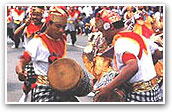 The eight administrative districts of Bali are the
regencies of Badung, Gianyar, Bangli, Klungkung, Karangasem,
Tabanan, Jembrana and Buleleng. Each Regency is administrated
by a Bupati (Regent), hence his know us a Kabupaten. The
Bupati is elected at a plenary meeting of the House of
Representatives at the Kabupaten level, whose members, as well
as those at the provincial level, are elected during general
elections. The eight administrative districts of Bali are the
regencies of Badung, Gianyar, Bangli, Klungkung, Karangasem,
Tabanan, Jembrana and Buleleng. Each Regency is administrated
by a Bupati (Regent), hence his know us a Kabupaten. The
Bupati is elected at a plenary meeting of the House of
Representatives at the Kabupaten level, whose members, as well
as those at the provincial level, are elected during general
elections.
Each Kabupaten is divided into
further Administrative Districts or Kecamatan, each under the
responsibility of a Camat liaison officer appointed by the
Bupati. These Kecamatan are further divided into a number of
Desa or Administrative Villages, which in turn consist of a
number of Banjar. The Banjar is organization of a number of
families based on a communal system.
A system of spiritual and family
affiliation exists simultaneously and in harmony with this
administration system. This is known as the Desa Adat or
traditional village, which can be traced back to the teachings
of a Javanese Hindu priest who visited Bali in the
11th century. Each Desa Adat has an elected
chairman, the Bendesa Adat, a man who is responsible for all
religious and traditional affairs amongst those people who
belong to the particular trinity of temples that he is in
charge of have a large display of modern Balinese gamelan
instruments, the gong, gender wayang, and cengceng that give
Balinese percussion its unique sound.
Ceramic and
Pottery
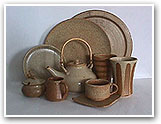 Ceramics were first brought to Bali by the Chinese,
almost a millennium ago, and yet the art was introduced here
much later, and in a much simpler form. Traditional pottery is
unglazed and fire-baked, very pure in form, and rather
brittle, but it serves a multitude of household purposes.
Kapal, just north of Denpasar, has a lot of small home
industries where pottery is thrown on foot-operated wheels.
They produce decorative garden pots of all shapes and sizes,
drinking flasks, water urns, decorative roofing tiles, vases,
ashtrays and satay stands. One of the company worth to be
visited is Balibata Ceramic at Jalan Raya Denpasar Tabanan.
The Bali Ceramics Institute, BPP. Teknologi, is a centre for
research and development for ceramics and porcelain. This is
situated on the Nusa Dua Bypass, in between Sanur and Kuta; a
picturesque building built on reclaimed land on the seaward
side of the road. The institute has an exhibition of work
produced by its students as well as ceramics from Kapal and
Lombok. Some items are available for purchase at very
reasonable prices. Ceramics were first brought to Bali by the Chinese,
almost a millennium ago, and yet the art was introduced here
much later, and in a much simpler form. Traditional pottery is
unglazed and fire-baked, very pure in form, and rather
brittle, but it serves a multitude of household purposes.
Kapal, just north of Denpasar, has a lot of small home
industries where pottery is thrown on foot-operated wheels.
They produce decorative garden pots of all shapes and sizes,
drinking flasks, water urns, decorative roofing tiles, vases,
ashtrays and satay stands. One of the company worth to be
visited is Balibata Ceramic at Jalan Raya Denpasar Tabanan.
The Bali Ceramics Institute, BPP. Teknologi, is a centre for
research and development for ceramics and porcelain. This is
situated on the Nusa Dua Bypass, in between Sanur and Kuta; a
picturesque building built on reclaimed land on the seaward
side of the road. The institute has an exhibition of work
produced by its students as well as ceramics from Kapal and
Lombok. Some items are available for purchase at very
reasonable prices.
Sanur has also a large pottery
studio, UD. Jenggala, which produces more refined pottery,
fired at high temperatures, with a limited range of very
attractive glazes. They sell their wares in an attractive
little shop, the Sari Bumi, on the main road at Batu
Jimbar.
Weavings
Perhaps the most popular cloth in
Bali is the locally made Endek, ikat weaving made on simple
hand looms in which the weft is tied (ikat) in prearranged
patterns and dyed prior to weaving. Up to five colours are
obtained in a lengthy process of retying and dyeing in a
series of different designs and colours.
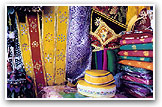 The
most common thread is the locally made rayon and cotton, or a
combination of both. In the most expensive materials pure silk
is used. Multiple hues are used from rich dark browns and
blues to pastel shades of yellow, orange, green, gray and red.
The resulting cloth is both colour fast and durable, and makes
attractive formal and casual wear. Traditionally it is used in
religious and formal attire as a wrapped around "kain" which
hangs beautifully, falling in folds according to the style
favoured by the wearer. On official occasions it is now
fashionable attire for both men and women, adapted to the
latest designs of shirts and evening gowns. Small endek
weaving factories are scattered all over the Denpasar area,
and it is worth a visit to see the women at work on their
simple looms creating vivid patterns. Most of these home
industries have sale outlets through local dealers in the
markets and art shops, but some will make direct sales,
depending upon the stock they have accumulated. One of
Denpasar’s larger weaving factories is the Pertenunan AAA in
Jalan Veteran No. 9, just north of the Bali Hotel. The
material is available in 2 ½ meter lengths for "kain", or can
be purchased by the meter. Here you can watch the entire
process from the preparation of skeins of thread, the tying
and dyeing, to the actual painstaking weaving of the cloth.
Another attractive locally produced material is the songket, a
brocaded material that has a design of gold or silver threads
woven into the weft on a plain-colored background. Generally
worn on special ceremonial and religious occasions, they are
woven in 2 ½ meter lengths to be used as "kain", as well as in
narrower, shorter pieces for men’s "saput", the standard hip
cloth that men wear over the sarong. Scarves known as
"selandang" are also popular for the requisite temple costume,
and "udeng", triangular head cloths for men. This delicate
material needs special care, and should never be washed, as
the warp colors are not fast, a factor that guarantees
permanent market demand. The
most common thread is the locally made rayon and cotton, or a
combination of both. In the most expensive materials pure silk
is used. Multiple hues are used from rich dark browns and
blues to pastel shades of yellow, orange, green, gray and red.
The resulting cloth is both colour fast and durable, and makes
attractive formal and casual wear. Traditionally it is used in
religious and formal attire as a wrapped around "kain" which
hangs beautifully, falling in folds according to the style
favoured by the wearer. On official occasions it is now
fashionable attire for both men and women, adapted to the
latest designs of shirts and evening gowns. Small endek
weaving factories are scattered all over the Denpasar area,
and it is worth a visit to see the women at work on their
simple looms creating vivid patterns. Most of these home
industries have sale outlets through local dealers in the
markets and art shops, but some will make direct sales,
depending upon the stock they have accumulated. One of
Denpasar’s larger weaving factories is the Pertenunan AAA in
Jalan Veteran No. 9, just north of the Bali Hotel. The
material is available in 2 ½ meter lengths for "kain", or can
be purchased by the meter. Here you can watch the entire
process from the preparation of skeins of thread, the tying
and dyeing, to the actual painstaking weaving of the cloth.
Another attractive locally produced material is the songket, a
brocaded material that has a design of gold or silver threads
woven into the weft on a plain-colored background. Generally
worn on special ceremonial and religious occasions, they are
woven in 2 ½ meter lengths to be used as "kain", as well as in
narrower, shorter pieces for men’s "saput", the standard hip
cloth that men wear over the sarong. Scarves known as
"selandang" are also popular for the requisite temple costume,
and "udeng", triangular head cloths for men. This delicate
material needs special care, and should never be washed, as
the warp colors are not fast, a factor that guarantees
permanent market demand.
Other Souvenir
Items
Die-cut wooden fans are made from
ebony and sandalwood in many places around Denpasar. They are
available in delicately carved shapes with "Bali" cutouts on
the leaves, or can be ordered with name cutouts for
personalized gift items, a 24-hour wait being required for the
finished product. There are several workshops in Thamrin
street, just south of the corner with Gajah Mada street, as
well as in Sesetan, south Denpasar. These fans also make ideal
promotional gift items, and the larger producers will prepare
special logo cutout dies for large orders.
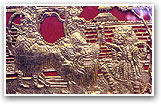 Finely carved name plaques, also ideal as
personalized gifts, are made from ebony or cheaper woods. The
name is etched out in relief and highlighted in gold, with a
surrounding detail of typical Balinese wood carving. There are
several places in Sanur where these can be ordered at 24-hours
notice, and a very reasonable price. Just ask at your hotel or
travel agency where the nearest workshop can be
found. Finely carved name plaques, also ideal as
personalized gifts, are made from ebony or cheaper woods. The
name is etched out in relief and highlighted in gold, with a
surrounding detail of typical Balinese wood carving. There are
several places in Sanur where these can be ordered at 24-hours
notice, and a very reasonable price. Just ask at your hotel or
travel agency where the nearest workshop can be
found.
The art of umbrella making in Bali
has nothing much to do with rain! The beautifully painted,
fringed umbrellas one finds in Bali are strictly decorative,
used more in the ritual, religious processions and ceremonies.
These exquisite gold-painted, tasseled pieces are thus in
continual demand, and workshops can be found in six out of the
eight regions of Bali. In Denpasar there’s large umbrella
studio on Patimura street and most markets have an entire
section devoted to ceremonial paraphernalia with brightly
colored umbrellas of all sizes and colors, some painted in
bold design with gold "perada" paint. Huge decorative fans
painted in a similar style are a recent offspring of this
craft, attractive items for interiors.
Batik
Cloth
Perhaps the most popular Indonesian
handicraft is Batik, the national cloth, which originates and
is generally produced in Java. This is in fact the everyday
wear of the local populace, who skillfully wrap a simple piece
of this material about themselves in various styles, creating
the most elegant item of clothing for both men and
women.
 Batik
cloth is decorated by hand in a dye resist process by applying
designs in wax and dyeing the material in a series of
different colors, a laborious process involving many steps.
The finest designs available are called batik tulis, which
means "written" batik, as the hot wax is applied with a tiny
pen known as a canting. Then there is the batik cap, which is
made by reproducing repetitive designs in wax with large
copper stamps, a much faster and therefore cheaper process.
Both these categories are usually waxed and dyed on both sides
with the same designs in order to promote uniform color
intensity, a prerequisite of high quality batik. A cheaper
cloth is now made with imitation batik designs reproduced by
machine or silkscreen process. This cloth is sold by the meter
rather than in lengths, and is generally considered
second-grade, often passed off as genuine batik. Batik
cloth is decorated by hand in a dye resist process by applying
designs in wax and dyeing the material in a series of
different colors, a laborious process involving many steps.
The finest designs available are called batik tulis, which
means "written" batik, as the hot wax is applied with a tiny
pen known as a canting. Then there is the batik cap, which is
made by reproducing repetitive designs in wax with large
copper stamps, a much faster and therefore cheaper process.
Both these categories are usually waxed and dyed on both sides
with the same designs in order to promote uniform color
intensity, a prerequisite of high quality batik. A cheaper
cloth is now made with imitation batik designs reproduced by
machine or silkscreen process. This cloth is sold by the meter
rather than in lengths, and is generally considered
second-grade, often passed off as genuine batik.
There are a number of reputable
batik showrooms in Denpasar, some of which have demonstrations
set up to show the entire batik-making process, with a wide
range of styles, lengths and ready-made items for
sale.
Educational
Institutions
Badung is the major centre of the
island of Bali for tertiary education. The State University of
Udayana has faculties of law, medicine, economy, architecture,
literature, languages and sciences as well as tourism, and
there are a number of private universities and Colleges that
offer similar professional courses. The Hindu Dharma
Institute, just north of Kesiman in east Denpasar, has an
undergraduate programme for degrees in religion and
philosophy.
Courses in Hoteliery and Tourism
are provided by the Balai Pendidikan Lembaga Perhotelan, the
Institute of Hoteliery and Tourism at Nusa Dua, which employs
foreign language teachers and has an exchange programme with
other countries in the ASEAN Region. Graduates from this
school, which offers training up to the managerial level, are
placed as trainees in hotels throughout Indonesia to gain
their practical experience. Educational programmes are often
arranged for the public also, in correspondence with
government projects to develop a better understanding of
tourism in the private sector.
The arts are extremely well catered
for in Bali by two large institutions, Akademi Seni Tari
Indonesia (ASTI), the national dance academy, and Konservatori
Kerawitan (Kokar), the Conservatory of the Performing Arts,
which is a lower level institution. ASTI was first established
in 1967 by the regional government of Bali, to train a new
generation of artist and scholars to help preserve, study and
develop the performing arts of Bali. It became a national
institute in 1969, and since then has been administered by the
Directorate General of Higher Education and Culture. The
curriculum offers dance, music and shadow puppetry.
Undergraduate students can attain a Sarjana Muda Bachelor of
Arts degree, and there is a graduate programme that awards a
Master of Arts degree, Seniman Seni Tari. A new curriculum is
being prepared for the future incorporation of the academy
into the Art Institution of Indonesia, (ISI) which will result
in the elevating of this school to the level of a State
University.
A key role in the annual Bali Arts
Festival is played by the students of ASTI, who create
extravaganza dance dramas each year that are extremely popular
with Balinese audiences. Performing groups from the Academy
are often called upon to give presentations for visiting
dignitaries. Strong ties with institutions in other countries.
The Ford Foundation and The Asian Cultural Council among
others, have led to a number of opportunities for study
courses in the United States for M.A. and Ph.D.
levels.
Foreign student programmes are also
available for dancers, musicians and musicologists wishing to
study Balinese choreography and music, and in 1986 ASTI had a
record number of 30 foreign students, some on scholarships and
government programmes, others pursuing private
interests.
Visits to both STSI and ASTI can be
extremely worthwhile for music and dance lovers, offering an
opportunity to watch classes in action and witness the
discipline involved in perfecting the many complicated aspects
of Bali’s performing arts.
Temple
Trips
Badung Regency is dotted with
historic temples, and for those interested in archeology,
traditional architecture or just the discovery of atmospheric
reminders of Bali’s rich heritage, there are a number of
fascinating spots to visit.
Pura Sakenan
This sea temple is linked to the visit of
Dang Hyang Nirartha in the 16th century, and has
the specific pyramidal "candi" shrines of that period.
Accessible by perahu from Sanur, Nusa Dua or Benoa, the temple
is on the tiny island of Serangan. It draws crowds of people
during its yearly festival on the day after Kuningan Beautiful
seashells are for sale here and there is a large enclosure
where turtles are raised for release into the sea to replace
the dwindling population of certain rare varieties. The trade
winds of July-August provide perfect kite flying conditions
and the children of Serangan fly huge kites, sometimes tying
them to their outrigger sailboats.
Pura Uluwatu
At the southernmost tip of the Badung
Regency the cliff top temple of Pura Uluwatu soars
majestically above the waves, with a sheer drop of at least
100 metres on three sides. This most sacred temple is said to
have been the place chosen by the saint Dang Hyang Nirartha to
attain "Moksha" or spiritual enlightenment. The architecture
of the temple is particularly striking, and a tribe of monkeys
in habits the surrounding cliff faces.
Pura Peti
Tenget
Just past the
Oberoi Hotel, up the coast from Legian, is the temple Pura
Peti Tenget, also founded by Dang Hyang Nirartha, who is said
to have defeated an evil horde of demons in this spot. Known
as a particularly "tenget" or spiritually powerful place, it
is referred to in the ancient "lontar" books as the place
where the Holy Scriptures from India (Vedas) were first landed
in Bali.
Pura Sada
This state temple of the Old Kingdom of
Mengwi, just 14 kilometers northwest of Denpasar in the
village of Kapal, was first established under Majapahit rule.
It has an unusual tall shrine or "prasada" dedicated to the
deified royal ancestors, and an imposing main gateway with a
massive demon head carved in fine detail.
Pura Taman
Ayun
Just a few
kilometers inland from Kapal can be found the official state
temple of the Mengwi Dynasty, Pura Taman Ayun. Established in
1634, it is a fine example of Balinese temple architecture,
with three ascending levels of spacious courtyards containing
rows of shrines and pavilions. The entire temple complex is
surrounded by a wide moat.
Pura Bukit
Sari
In the midst of the
Sangeh Monkey Forest is can ancient temple, Pura Bukit Sari,
which dates back to the 17th century, when it was a
sanctuary for meditation. The stand of towering nutmeg trees
is home of a tribe to monkeys, and its popularity as a tour
destination is in great part due to these inquisitive.
|

